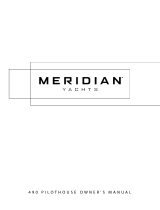
v1.0
Owner’s Manual
Fuel System - 26 Viking Sport Cruiser 61FY
••••••••••••••••••••••••••••••••••••••••••••••••••••••
Refueling the Vessel
After Fuelling:– Clean up any fuel
spilled on the deck and dispose
of rags ashore. Reinstall fuel
deck plates and tighten down.
Open the windows and deck
hatches. Check for diesel odor
in cabins. Inspect engine room
tanks for any fuel leakage. Switch
on ignition (but don’t start) to run
engine room blowers for at least
5 minutes. As soon as possible
after that start the engines and
move away from the fuel dock
area.
Water-in-fuel alarm
Warning light and alarm C indi-
cates excessive water in the
Separ fuel bowl. This must be
drained off as soon as possible.
Fuel Deck Plate
Importance of keeping tanks topped up
Fuel tanks should be kept topped up. In a heavy sea
with low fuel the motion of the vessel could allow the
fuel pickup to draw in air instead of fuel.
Tanks left half full of diesel oil are subject to condensa-
tion which promotes rapid growth of algae. When the
fuel tanks are filled, the algae die and foul the fuel in
the tank. Result: dirty fuel filters that must be cleaned.
Antibacterial additives such as Biobor JF or Technol
403 will help
with this prob-
lem, but keep-
ing the fuel
tanks topped
up will reduce
algae growth.
Fuel quality:– Cut price fuel can contain water and other
contaminants. Refuel only at a reputable dealer; it saves
money in the long run. It is best to refuel late in the day to
minimize fuel tank condensation.
Antibacterial additives:– In Florida, especially, fuel tanks
become contaminated with microorganisms. Algae coats
the outside of the filter element causing filters to easily
plug up, particularly the primary fuel filter. If the engines
are starved of fuel because of clogged filters engine power
is reduced and the piston rings may be damaged. Be sure
to always install a 30 micron element in the Separ Fuel
Filter – anything smaller will clog up quickly, and there is
no gain in it.
Antibacterial additives such as Biobor JF must be used to
kill these contaminates. There are many brands on the
market – use them liberally and all the time.
Procedure:– Refueling has to be from both sides. The fill
caps are under deck plates A at the side deck steps and
are clearly marked DIESEL. Fill both tanks to the same level.
During fueling the vessel must be securely tied up. All
windows, doors and hatches closed. All electrical equip-
ment switched off. Have a fire extinguisher handy.
All crew and passengers should be off the vessel. One
person aboard to monitor the refueling. NO SMOKING.
The fuel gauges B are a very reliable magnetic type gauge,
but no fuel gauge is 100% accurate. With experience, you
will get to know about how much fuel you need and how
accurate your own gauges are.
Allow for fuel expansion. DO NOT OVERFILL. Unless you
require maximum range, when the gauge indicates full,
stop there. If fuel comes out of the overboard vent stop at
once.
Environmental laws prohibit fuel oil
contamination of sea and lake
water. Be responsible in disposing
of discarded fuel. Always inspect
for leaks when in the engine room.
B
A
C
C
B
C
B







